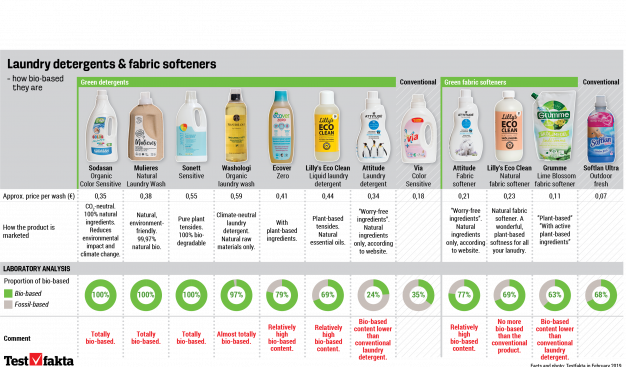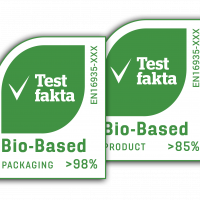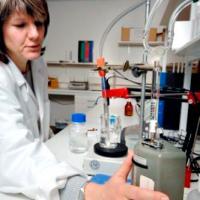Consumers’ growing interest in sustainability has hardly gone unnoticed by companies. Today, terms like ‘plant-based content’, ‘natural’, ‘vegan’ and ‘worry-free ingredients’ are sprinkled liberally across the packaging of many laundry detergents and fabric softeners on store shelves.
A plant-based or bio-based product is made wholly or partly from renewable sources from the plant or animal kingdom, as opposed to fossil and non-renewable sources such as oil and coal.
How much of the detergent content comes from bio-based raw materials is not always stated, however. And if it is, how do consumers know it is correct?
To find out the truth, Testfakta analysed the proportions of fossil and bio-based content in 10 ‘alternative’ laundry detergents and fabric softeners, and compared the results with those from two conventional products. In the testing, we used the classic carbon-14 dating method, which also serves to determine the antiquity of archaeological finds.
— Both biomass and fossil raw materials contain the element carbon. The method gives answers about whether the carbon atoms in the detergent come from new bio-based material — plants and animals, that is — or from fossil raw materials such as oil and coal,’ explains Marcus Vestergren of RISE Research Institutes of Sweden, who conducted the test on Testfakta’s behalf.
The results show that several of the alternative products are no more bio-based than the conventional ones. In a couple of cases their bio-based content is even lower.
[PDF]
One example is the laundry detergent from the Canadian company Attitude. The product displays no indication of the plant-based percentage, but according to the company’s website only natural ingredients are used. Judging from the ingredients list, most of the content seems to come from coconut and maize. The front of the packaging shows three merry penguins beneath the phrases ‘worry-free ingredients and ‘live consciously’.
Nevertheless, Testfakta’s analysis shows that Attitude’s detergent is only 24% bio-based. This is well below the proportion in the conventional detergent from Via and falls a long way short of the truly bio-based products in the test, which in several cases are 100% bio-based.
Hans Drouin, Vice President of Research and Development at Attitude tells Testfakta that the company’s products respect both the environment and human health, and refers to UL Environment’s Ecologo Certification.
— The bio-based content is only a small fraction of the whole, and says nothing about the total impact of the product on health or the environment. We use renewable energy, engage in climate compensation and carefully select all the ingredients to avoid any substances harmful to health.
Another example, perhaps worse, is the plant-based fabric softener from Grumme. According to the owner Orkla’s website, the product’s content is 100% plant-based, but more than a third is actually derived from fossil sources. What is more, Grumme’s fabric softener has a lower proportion of bio-based content than Softlan, Colgate Palmolive’s conventional fabric conditioner.
When Testfakta contacted Orkla, the company swiftly changed the text on the website. According to Anne Gjemdal, Orkla’s Communications Manager at Home & Personal Care, it was never their intention to claim that the product was 100% plant-based.
— It was due to an error in our internal routines. We strongly regret this and will tighten up our procedures so that nothing similar happens again,’ she said.






